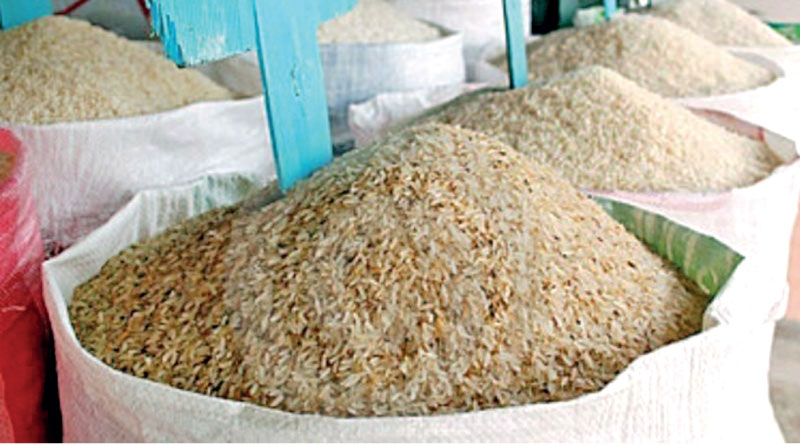Monday Nov 18, 2024
Monday Nov 18, 2024
Monday, 18 November 2024 00:25 - - {{hitsCtrl.values.hits}}

|
 It was in the 17th Century that Sir Isaac Newton explained the Law of Gravity after observing an apple falling from a tree in his mother’s garden. Rice, eggs, and coconuts are subjected to the same law as particles of matter, but not their prices. The hike in price to unaffordable levels has been the talk of the town for some time but has reached new heights, bringing in an unprecedented challenge to the newly elected President and his small cabinet. The event provided substance for the other political parties who thrived for power in the new Parliament to be in control in a few days.
It was in the 17th Century that Sir Isaac Newton explained the Law of Gravity after observing an apple falling from a tree in his mother’s garden. Rice, eggs, and coconuts are subjected to the same law as particles of matter, but not their prices. The hike in price to unaffordable levels has been the talk of the town for some time but has reached new heights, bringing in an unprecedented challenge to the newly elected President and his small cabinet. The event provided substance for the other political parties who thrived for power in the new Parliament to be in control in a few days.
Many verbal submissions have been made by consumers and other players in the food system, such as farmers, millers/processors, wholesalers, and retailers, regarding the recent price hike in rice, eggs, and coconuts. This article focuses only on the price of rice to provide a holistic view.
The Executive President of Sri Lanka has also met many players in groups, especially in the rice industry, including Government officials, large-scale millers, small-scale rice millers, etc., to find immediate and long-lasting solutions. It is indeed a welcome move. However, meeting these stakeholders separately will mainly focus on their own problems rather than solving the national issue. Hence, the advice is that the President, with top officials of the Ministry of Agriculture and Department of Agriculture (including Provincial Departments of Agriculture), meet the representatives of al stakeholder categories listed above at the same meeting, who are the key nodal points of the food system. I suggest that these meetings occur twice a season, i.e. at the beginning and towards the end of the cultivating season in the case of paddy, to facilitate the determination of paddy and rice prices.
Price determination of rice
There is no argument that each player in the supply chain should get their fair share unless there is a move to remove or limit the number of intermediaries at different nodal points of the food system. It is not an easy task. I also see the mentality of many, including some learned groups, to discipline the large mill owners, assuming they are the leading group destabilising the rice market. Similar sentiments were expressed by many over the past few decades, however, the problem remains the same. This line of thinking will not support the Government efforts to provide good quality rice at an affordable price.
Calculations that have led to adopting a control price for paddy and rice start from the price of inputs and cost of overall production, milling, transportation, storage, etc. The latter would include the drying cost (if paddy is purchased above the moisture content of 14% as required for proper storage), transport cost, parboiling costs (if done), warehouse costs and other wastages (that the Department of Agriculture estimates at 6%). We do not need rocket science to understand that the price of milled rice will depend proportionately on any cost component. The consensus is that the consumer price of parboiled rice would be twice that of paddy. The final price generally includes the profit margin for the miller (approx. Rs. 3 per kg), wholesaler (approx. Rs. 1 per kg) and retailer (approx. Rs. 2 per kg). It seems a fair margin to ensure that the milling industry will survive; however, in a situation where fluctuating transport and electricity costs and an increase in labour wages and machinery spare parts, these values and the control prices should be revisited regularly. Once again, the objective should not be to teach a lesson or discipline any players in the food system but to fix a fair price. It is essential to understand that no one will do business for charity.
Rice availability in the country
The most recent crop forecast done by the Department of Agriculture (released on 15 September 2024) indicates that the total harvest of Maha (2023/2024) and Yala (2024) seasons have resulted in a total paddy availability of 4.24 million Mt. Assuming a per capita consumption of 112.3 kg per annum, the DOA has also estimated the total rice requirement of the country as 2.46 million Mt. The conversion depends on many factors. Usually, a new paddy harvest is not milled immediately due to high breakages. Further, the milling outturn will rely on the rice variety (e.g. keeri samba has a relatively low milling outturn of about 62%), and the condition of mills (type of machinery, etc.) will also significantly determine the milling outturn. With all these variations, an average milling outturn of 68% (e.g. milling 100 kg of paddy will return 68 kg of rice) is generally considered by the Department of Agriculture in determining the rice availability of the country, where it is estimated as 2.88 million Mt. A simple calculation would not show that the surplus rice availability of Sri Lanka in 2024 is 422,260 Mt. A good achievement.
Though the milling percentage set by the DOA is an average of a broader range and will indicate rice availability in the market, I also see a glitch in this calculation. First, the DOA has assumed that rice is not used for animal feed and manufacturing, most likely including beer production. Though this is an assumption based on the gazette issued by the Consumer Affairs Authority gazette notification 2185/67 issued on 23 July 2020 prohibiting the use of rice for animal feed production, it is not a secret that the poultry and beer industry uses rice (including broken rice) in their industries. It no doubt affects the rice availability.
Further, the Institute of Postharvest Technology and Management (IPHTM) identifies the milling outturn of rice to be 62-65% (still depending on various factors, as explained previously). The leading millers fix it around 62.5%, and the small and medium millers indicate it lies between 52% and 63%. Thus, in all other estimations, the milling outturn has been considered at much lower levels than assumed by the DOA. There is a vast discrepancy. It seems that the calculation using 68% milling outturn would exaggerate the rice availability in the country.
Outcry on availability of “Keeri Samba” and “Nadu” rice
There is an outcry on the availability of “Keeri Samba” and “Nadu” rice, and the price ranges in the market fluctuate between seasons. The cultivated extent and yield of a crop depends on the supply of good quality planting material. As for rice, the annual total requirement of the seed paddy (about 128,000 to 140,000 Mt per year) is supplied locally, of which only 16% is certified seed paddy provided by the DOA and the private sector. However, it is the farming community who decides on the rice variety to be cultivated, in more than 80% of the paddy lands of the country. This decision usually has a bigger influence on the market values of the previous seasons’ varieties. A decision, or at least advice, by the Ministry of Agriculture on the cultivated extent of different categories of rice in the forthcoming season will guide the farming community to some extent in overcoming this issue. Otherwise, this will become an eternal problem in the rice markets, with the price of rice continuing to emerge as a main news item.
Then comes the storage of rice. I am happy to learn that the Paddy Marketing Board has planned to procure about 300,000 Mt of rice from the market at the end of the Maha season 2024/2025. It is commendable and will help stabilize the supply to some extent. In previous years, the same idea was floated. However, we learned that the paddy farmers did not want to sell their harvest, and the Treasury did not release adequate finances to the PMB to procure paddy. The PMB purchases paddy brought to them, which have been dried to lower moisture levels (at least 14% moisture content) to facilitate storage. However, many private sector giants purchase paddy at a higher moisture level by visiting the farmer fields, but at a lower price than the ‘control price’. It is natural as the buyer will be paying for additional moisture, and drying them will add to the cost of processing.
In 2023, the Public Expenditure Review Committee (PERC) on Agriculture recommended refurbishing the 325+ paddy warehouses, with a total of more than 350,000 Mt capacity, established in different parts of the country to ensure the storage conditions will be improved. A recommendation has been made to do the repairs and refurbishments on a priority basis by selecting facilities if paddy purchase by PMB at the end of this Maha season is to become a reality.
A political game
Overall, the paddy and rice prices seem to be a political game but can be sorted out to a greater extent based on more coherent policies, planning and implementation mechanisms. Paddy and rice prices are socially sensitive issues that cause headaches for any government at different periods of the year. It is a pride of Sri Lankans to consume the rice produced locally. However, when the need arises, we will not hesitate to import rice to bridge the gap based on the requirement. Further, we may be unable to stop importing rice altogether, as the tourism industry demands specialty brands like Basmati, Jasmine rice, etc. Apart from such imports, there is a need for a pragmatic approach to ensure that our rice requirement is met through local production. Such efforts should focus on the overall development, without pin-pointing selected segments in the food system.
In conclusion, we grumble about food prices mainly due to the high cost of production and the weak purchasing power of the consumer. Efforts to expand the overall economy and a strengthened food flow coupled with strong market mechanisms would be the best solution, avoiding any intervention that would shrink it.
(The writer is Professor in Crop Science, Faculty of Agriculture, at the University of Peradeniya.)